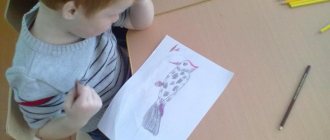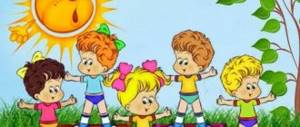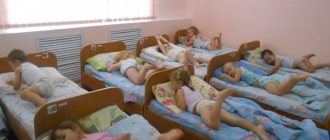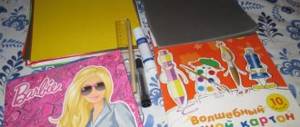“Corrective gymnastics for preschoolers”
“Corrective gymnastics for preschoolers”
Preschool age in the development of a child is the period when the foundation of his health, physical development and culture of movement is laid. However, an analysis of the available data shows that the state of children’s health at present is far from meeting either the needs or potential capabilities of modern society.
Mentally retarded children have a wide variety of developmental disorders, which must be taken into account when designing physical education classes: from the cardiovascular and respiratory systems, as well as physical development and motor skills.
Identifying the capabilities of a mentally retarded child and correcting his developmental defects require special methodological techniques, which should, first of all, be presented in an accessible form. Thus, physical education should be aimed at correcting the physical development of children, deviations in somatic condition and motor skills, as well as at strengthening the health and hardening of the child’s body, promoting proper development, and teaching motor skills.
Corrective exercises are of great importance not only for strengthening the muscles of the body and all-round physical development. They affect the cardiovascular, respiratory and nervous systems. By performing exercises for the arms, legs, and torso, children learn to control their movements, perform them deftly, coordinatedly, with a given amplitude in a certain direction, tempo, and rhythm.
Corrective gymnastics consists of 3 parts: introductory, main and final.
The purpose of the introductory part is to increase the emotional state of children, activate their attention, and prepare the body for the loads of the main part. The content of the introductory part includes drill exercises, various types of walking and running, jumping, exercises for correcting posture and preventing flat feet, and teaching proper breathing. This part ends with children lining up in columns or groups to perform general developmental exercises.
The main part includes general developmental exercises. Exercises are given to develop and strengthen the muscles of the shoulder girdle, abdomen, back and legs, and for the flexibility of the spine.
The exercises are performed from different starting positions - standing, lying, on your back, and on your stomach, sitting. This helps improve the quality of movements, increases the load, and all muscle groups are involved in the work.
To restore the heart rate, gymnastics ends with a final part, which includes physical exercises with a gradual decrease in tempo. (Annex 1)
(Annex 1)
Physical exercises and the content of corrective gymnastics.
Introductory part.
- Form a column one at a time. Walk at an even pace.
- Walking on your toes, on your heels, on the inner and outer arches of your feet, with different hand positions.
— Walking with a bag on the head with simultaneous various movements: in a half-squat, with high knees.
- Normal running. Running with overwhelm. Walking is normal. Walking on a ribbed board, walking on pebbles.
- Walking on a stick sideways with an extension step.
- Running on your toes with high knees.
- Walking on an inclined plane on your toes. Walking is normal.
- Formation from a line into a circle, holding hands. Opening with outstretched arms to the sides.
General development exercises:
1. From the starting position “standing”, lifting on your toes, rolling from your toes to your heels.
2. I. p.: kneeling, hands down. 1 - right hand on the left shoulder. 2 - bend forward, touch the floor with your right elbow; 3-4 - reverse movement. Same with the other hand.
3. "Boat". I. p.: lying on your stomach, arms along the body. 1- bend your legs, grab the ankle joint with your hands. 2-3 use your hands to stretch up, 4- return to i. P.
4. "Wheel". I. p.: lying on your back, arms along the body. 1-2- raising straight legs up, touch the toes of your feet to the floor behind your head. 3-4- return to i. P.
5. “Log”. I.p.: lying on your back, arms up, roll from back to stomach, roll from stomach to back.
6. “Self-extension.” I. p.: lying on your back, arms up. For three counts, stretch upward, stretching the spinal column, with your toes towards you. I. p.: relax.
7. "Fish". I. p.: lying on your stomach, hands above your chin. Maintaining the middle position of the spine, move your arms straight back, bent at the knees, and raise the “fish”.
8. I. p. lying on your back, hands under the lower back. Bend your knees, pull them towards your stomach; Without raising your legs high, straighten them.
9. Jumping in place with your knees raised high.
10. Perform breathing exercises while lying on your back “x-x-ho”, “x-x-ho” - warm your hands - exhale; “f-f-f”, “f-f-f” - cool the water - exhale, “smell a flower” - inhale.
Final part:
— Walking in a column one at a time.
- Running at a fast pace.
- Normal walking.
— Massage of arms and legs - tapping the legs and arms with your fingers.
Gymnastics after sleep (corrective) in kindergarten
Sleep plays a vital role in a child's daily routine. How the baby wakes up depends on his mood, state of health and how he will spend the rest of the day.
In kindergarten, organizing a proper awakening is more difficult than for parents at home, because it is necessary for 15, 20, or even 30 people to throw off the shackles of Morpheus almost simultaneously, and to do it correctly.
Solving such a problem is not easy, but with knowledge of some methodological nuances it is quite possible.
Gymnastics after sleep is a set of exercises that provide a smooth transition from calmness to wakefulness.
The objectives of such classes are:
- increase in muscle tone;
- improved mood;
- prevention of colds;
- strengthening the respiratory system;
- preventing the development of problems with posture, flat feet;
- fostering the habit of stretching the body after waking up.
Not only his mood, but also the emotional atmosphere of the entire group depends on how each child wakes up.
To achieve the goals, every day the teacher selects exercises to solve problems such as:
- toning the nervous system (that is, preventing irritability and anxiety that may arise after waking up);
- improving the functioning of the body’s main systems (cardiovascular, respiratory, as well as stabilizing the body’s protective functions);
- creating a positive atmosphere in the group.
All this is possible with the right combination of gymnastics techniques after sleep.
- The plot of the awakening. This technique is especially important for children of the first and second junior groups. The essence of the technique is that all exercises are carried out within the framework of a common plot. For example, a bear came to visit us and asked for help: her son Mishka could not wake up, and he needed to go to help his mother to pick raspberries for the winter - he needed to show by example how to quickly restore the body after sleep. In addition, it will be more interesting for children to perform certain actions accompanied by rhymes and short sayings.
- Musicality.
Quiet, relaxing music, played a little louder than before bed, helps children of any age recover. Gymnastics after waking up should be done to music - Lying exercises. These complexes help to gradually restore muscle tone and move on to more active actions. Again, for children, more attention is paid to this block of exercises, since the younger the children, the more difficult it is for them to adapt to active activity after sleep.
- Active block of gymnastics (or “mat exercises”). It includes tasks that are performed while standing. The complex includes swinging arms, legs, body turns, squats, walking on massage mats, etc. For children in older groups, tasks such as complexes play a very important role in developing correct posture.
- Breathing exercises. For children of the middle - preparatory groups, this is almost the most important stage of work, since, in addition to the task of general strengthening of the body and the respiratory system in particular, exercises help develop correct sound pronunciation, which is very important for children who are fully mastering speech or those who have problems with the speech apparatus.
More information about gymnastics after sleep in the preparatory group can be found in our article - We conduct gymnastics after sleep in the preparatory group of the kindergarten.
Gymnastics after sleep in some sources is called corrective, and sometimes includes corrective in its range of types.
. Corrective gymnastics (from the Latin corrigo - straighten, correct) is a type of therapeutic gymnastics - special exercises to eliminate postural disorders; it also has a general strengthening effect (trains the functions of the cardiovascular and respiratory systems, strengthens individual muscle groups); restores balance between the curvatures of the spine.
Based on the definition, which includes the main goals and objectives of performing exercises after sleep, we can conclude that gymnastics after sleep, invigorating and corrective are all terms of the same synonymous series. Types of corrective exercises can be:
- correctional exercises (exercises aimed at correcting some specific disorders in the functioning of the child’s body, for example, flat feet or curvature of the chest);
- hardening (except for walking, hardening is not the lot of many people, because this is a special type of health procedures, which is carried out, as a rule, in specialized groups, it includes washing with cold water, dousing on the street, etc.);
- lazy gymnastics (exercises that are performed lying down, sitting, without sudden movements of strong physical exertion);
- physical education minutes (conducted regularly during breaks during classes, so that children not only take a break, but also work to strengthen the body);
- preventive gymnastics (a universal set of exercises that is most often used in preschool institutions).
. Preventive gymnastics is sometimes called invigorating.
Types of exercises
If we talk about corrective gymnastics after sleep, it includes:
- exercises immediately after waking up - in bed;
- exercises using exercise equipment (for example, massage mats, balls, etc.);
- corrective tasks to prevent flat feet, spinal curvature, etc.;
- breathing exercises.
To prepare children for the period of wakefulness in the afternoon, it is worth following a number of recommendations developed by the experience of teachers:
- The air temperature in the bedroom should not be lower than +16/+18 degrees.
- You need to choose a set of exercises taking into account the activities you had before going to bed. For example, before lunch the kids had a story game, which means that after sleep they can pay more attention to a block with squats, jogging, and body turns.
- For those little ones who wake up earlier, it would be a good idea to prepare 1-2 sets of exercises, for example, the “lazy” type.
Children who wake up earlier should be occupied with exercises so that they do not wake up those who are still sleeping. - Children should wear shorts and a T-shirt. If we are talking about the cold season, then pajamas. To perform exercises on the mat, you should wear shoes or socks.
- No coercion. If the little sun refuses to work together with everyone, then you absolutely cannot scold him. You just need to find out what caused this behavior.
- In the summer, a block of active exercises is recommended to be carried out outdoors.
- During the exercises, relaxation should be longer than tension.
- Instructions for implementation should be repeated more or less times depending on the emotional state of the kids.
If we summarize the above-mentioned features of the organization of corrective gymnastics, we can come to the conclusion that the optimal ratio would be a combination of 2-3 exercises in bed, 1-3 on the floor or on a rug and 2-3 breathing exercises performed to calm music (for example, sounds of nature or classics). In general, it will take 5–10 minutes to complete the gymnastics.
Spending 5-10 minutes after sleep helps maintain and improve children's health
Table: card index of exercises after sleep
This complex can be called universal, since it is aimed at preventing health problems. As for age characteristics, the differences will be in the frequency of execution and the number of exercises. So, for the first younger group, the “Exercises in bed” block remains unchanged, but the second and third blocks can be shortened.
Visibility for gymnastics
As is known, in preschool children the visual-figurative perception of the world is in the lead. Completion of tasks should be accompanied by bright, appropriately sized:
- pictures;
- soft toys;
- slides;
- posters.
The leading position remains with the toy. The fact is that children perceive her as a friend, comrade, which means they are more willing to complete the task. For younger groups, such a character serves as a role model, and for older groups - a younger comrade who needs the help of older friends.
If it is possible to show the kids slides, for example, with the hero who came to wake them up today, then such a transition to wakefulness will be easy and healthy.
A massage mat can also be used as a visual aid: for example, if it is a forest path or a bridge over a river
Scheme of analysis of gymnastics after sleep
To understand whether conducting exercises after sleep in a particular kindergarten group is effective, you need to evaluate each of the stages of its implementation according to the scheme. First you need to specify:
- name of the preschool institution and group;
- teacher's name;
- date;
- age of children;
- number of children in the group.
Table: sample analysis scheme
Gymnastics after sleep is very important for children. After all, with its help, kids not only restore their tone, but also learn to take care of their health. And maintaining and restoring the child’s normal well-being is one of the main tasks of his stay in a preschool educational institution.
Source: https://melkie.net/zanyatiya-s-detmi/korrigiruyushhaya-gimnastika-v-detskom-sadu.html






